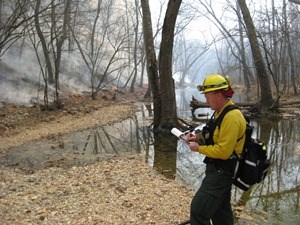
NPS Photo by Dena Matteson In order for fire managers to make sound management decisions about prescribed burning, the effects of fire on native habitats and species are documented and analyzed. This information is gathered through methodical scientific surveys of monitoring plots within each of the prescribed burn units managed by Ozark National Scenic Riverways. Fire effects monitors gather a variety of information, including size and species of trees, measurements of leaf litter and duff, and quantities of herbaceous plant species. This data, known as "fire effects data", is collected at specific intervals before and after a prescribed burn, so that comparisons can be made by analyzing the changes in vegetation. Desired future conditions have been established for each prescribed burn unit and the analysis of the fire effects data helps managers determine if those goals are being met. There have been a number of "success stories" that illustrate the importance of fire for our native landscapes and species. The fire management staff at Ozark National Scenic Riverways is proud to be a part of management efforts that have aided the conservation of fire-dependent species. For more information, click on the links below: 
|
Last updated: December 16, 2021
